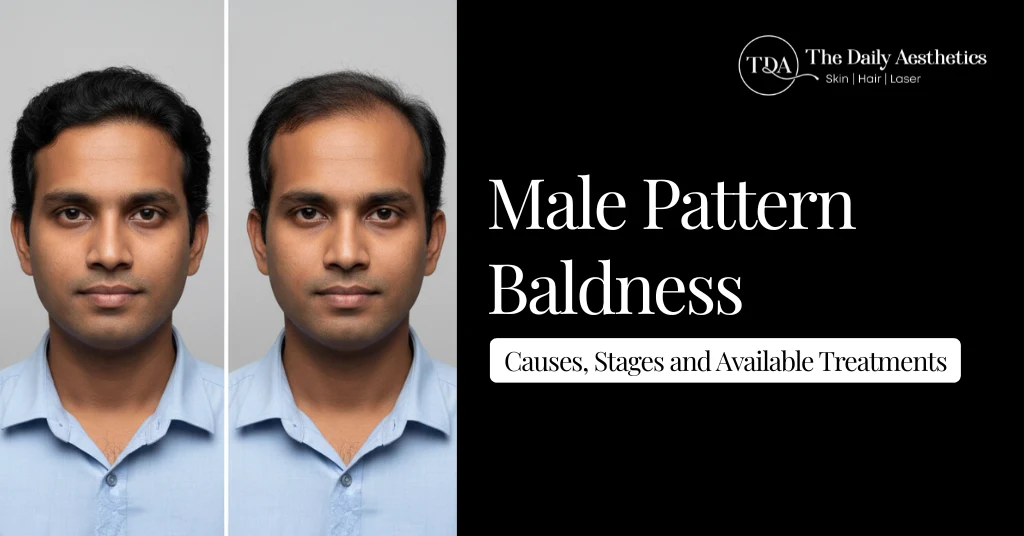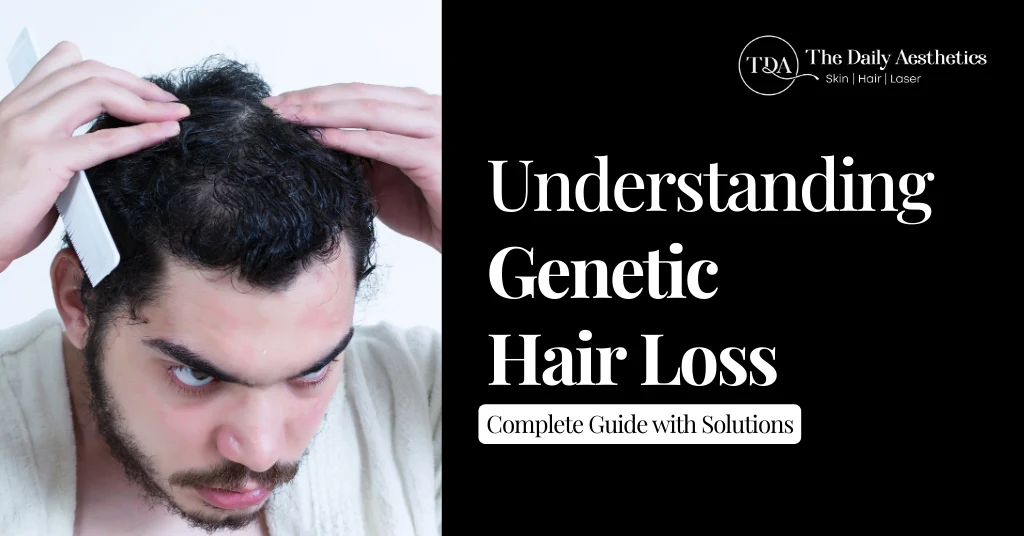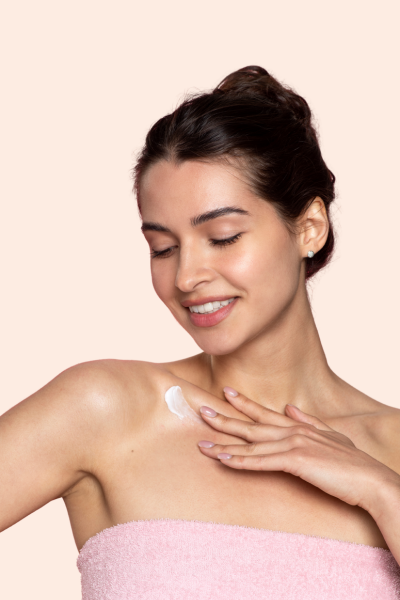If you’ve started noticing more hair on your pillow, in the shower drain, or even just a slightly higher forehead than before, you’re not alone.
Hair loss is one of the most common concerns men face—and it can feel frustrating, even a little scary.
But here’s the truth: male pattern baldness isn’t just about age or bad luck. It’s a combination of genetics, hormones, and a few lifestyle factors working together over time.
By the age of 50, around 85% of men experience some degree of hair thinning.
The good news? Today’s treatments are more advanced than ever, and early action makes a huge difference.
In this guide, we’ll walk you through everything you need to know about male pattern baldness—from what causes it, how to recognize it early, and which treatments actually work.
What Is Male Pattern Baldness?
Male pattern baldness, also called androgenetic alopecia, is the most common form of hair loss in men.
It usually starts with a receding hairline at the temples or thinning at the crown.
Over time, these areas can merge, creating that classic “M-shaped” hairline many men recognize.
The key thing to know is that male pattern baldness doesn’t happen overnight. It’s a gradual process caused by changes in the way your hair follicles grow. Each strand of hair grows from a tiny follicle in your scalp.
In men prone to baldness, these follicles slowly shrink and produce thinner, shorter hairs over time—until eventually, they stop growing new hair altogether.
This process is called follicle miniaturization, and it’s mainly triggered by hormones (we’ll get into that next).
The good news? If you catch it early, it’s possible to slow down, stop, or even reverse some of that follicle damage with the right treatments.
The Role of Hormones (DHT and Testosterone)
You’ve probably heard of testosterone—the hormone responsible for things like muscle growth, deep voice, and facial hair.
But testosterone also converts into another hormone called DHT (dihydrotestosterone).
For men genetically sensitive to DHT, this hormone can bind to receptors in their hair follicles and cause them to shrink. Over time, those follicles produce weaker, thinner hair—until they stop producing visible hair at all.
DHT is like a bully to certain hair follicles. Some follicles can handle it just fine, while others are more sensitive. That’s why some men go bald early while others keep a full head of hair for life—it all depends on your genes and how your scalp reacts to DHT.
The experts at The Daily Aesthetics often explain it this way:
“It’s not about how much testosterone you have—it’s about how your follicles respond to DHT.”
Fortunately, several proven treatments can block or reduce DHT activity, helping your follicles stay active longer.
Male Pattern Baldness: Myths vs Facts
Let’s clear up a few common misconceptions about baldness—you’ve probably heard some of these before:
Myth: Baldness comes from your mother’s side.
Fact: Genetics from both sides of your family play a role. You can inherit the tendency from either parent.
Myth: Wearing hats causes baldness.
Fact: Nope. Hats don’t block follicles or “suffocate” your scalp. Baldness starts from within, not from what you wear.
Myth: Washing or styling your hair too much makes it fall out.
Fact: Hair shedding during washing is normal. You’re just seeing the hair that’s already at the end of its growth cycle.
Understanding these truths can help you focus on what really matters—addressing the root causes instead of chasing myths or miracle shampoos.
Male Pattern Baldness Causes and Risk Factors
1 Genetic Factors
If you’ve noticed that your dad, grandfather, or uncles share the same receding hairline pattern, chances are your genes might be playing a big role in your hair story too.
Male pattern baldness is largely hereditary, which means it’s passed down through families.
But here’s the thing: it’s not as simple as saying, “You get it from your mom’s side.” That’s one of the biggest myths. The truth is, baldness can be inherited from either side of your family because it involves several genes, not just one.
Researchers have identified the AR gene (androgen receptor gene) as one of the key players.
This gene affects how sensitive your hair follicles are to DHT (dihydrotestosterone), the hormone that contributes to follicle shrinking. If your follicles are more sensitive to DHT, they’ll start to weaken earlier in life.
Some men start noticing changes as early as their late teens or early 20s, while others hold on to their hair well into their 40s or 50s. It all comes down to genetic sensitivity.
2 Hormonal Changes
Hormones play a huge role in how your hair behaves—and sometimes, they can be your hair’s biggest enemy.
Your body naturally produces testosterone, which is converted into DHT by an enzyme called 5-alpha-reductase. DHT is useful for things like sexual development, but it has a not-so-great side effect when it comes to your scalp.
For men who are genetically predisposed, DHT binds to hair follicles, making them smaller over time. This leads to shorter, thinner hairs that eventually stop growing altogether.
Even though you can’t stop your body from producing DHT completely (and you wouldn’t want to), there are treatments that can block its effects on your scalp—like finasteride, a medication that targets the enzyme responsible for DHT production.
3 Lifestyle and Environmental Influences
While genes and hormones are the main culprits, your lifestyle can either make things better or worse.
The way you eat, sleep, and handle stress all play a role in keeping your hair healthy.
Let’s break down some of the biggest factors:
- Stress: High stress levels can push your hair follicles into a resting phase, causing more shedding than usual. Chronic stress also increases inflammation, which can worsen thinning.
- Diet: Your hair needs nutrients like iron, zinc, biotin, and vitamin D to stay strong. Skipping meals or eating processed foods regularly can starve your follicles of what they need.
- Smoking and Alcohol: Both restrict blood flow and oxygen to your scalp, slowing hair growth.
- Lack of Sleep: Your body regenerates and repairs cells while you sleep—including those in your scalp. Less sleep = slower regrowth.
- Environmental Damage: Constant exposure to UV rays and pollution can weaken hair strands and cause scalp irritation.
The good news? Simple changes like eating balanced meals, exercising, staying hydrated, and getting enough rest can help your scalp stay healthier and make treatments more effective.
4 Medical Conditions and Medications
Sometimes, hair loss isn’t just about genetics or lifestyle—it can be a side effect of certain health conditions or medications.
Here are a few examples:
- Thyroid disorders: Both hyperthyroidism and hypothyroidism can cause diffuse hair thinning.
- Anemia: Low iron levels can reduce oxygen flow to hair follicles.
- Autoimmune diseases: Conditions like alopecia areata cause your immune system to attack hair follicles.
- Medications: Some drugs for blood pressure, depression, gout, and heart disease can trigger or worsen hair loss.
If you suspect your hair loss might be linked to a medical condition, don’t self-diagnose. A dermatologist or trichologist can help pinpoint the real cause.
Stages of Male Pattern Baldness
Male pattern baldness doesn’t happen overnight. It moves slowly, step by step, and the earlier you spot it, the easier it is to control.
Doctors and hair specialists use something called the Norwood Scale to measure these stages. It’s basically a visual guide that helps you (and your dermatologist) figure out how advanced your hair loss is — and what treatment makes the most sense for your stage.
What is the Norwood Scale?
The Norwood Scale has seven stages, ranging from a barely noticeable receding hairline to near-complete baldness.
Here’s a simple breakdown:
- Stage 1: Minimal or no recession at the hairline. You might just notice some thinning, but nothing major yet.
- Stage 2: The classic “M-shaped” hairline starts to form as the temples recede slightly.
- Stage 3: Hair loss at the temples becomes deeper and more visible. The crown (top of the head) may start thinning too.
- Stage 4: The recession deepens, and a noticeable bald spot forms at the crown. A thin strip of hair separates the front and crown areas.
- Stage 5: The bald areas begin to merge, leaving only a narrow band of hair across the top of the head.
- Stage 6: The bridge of hair connecting the sides and back starts to fade. The bald region expands across most of the scalp.
- Stage 7: This is the most advanced stage. Only a horseshoe-shaped band of hair remains along the sides and back of the scalp.
If you were to look at a Norwood chart (something the experts at The Daily Aesthetics often use during consultations), you’d see exactly how your pattern compares — and that’s a huge help when deciding which treatment path fits you best.
Early Signs to Watch For
Male pattern baldness often starts subtly — so subtly that you might miss the early signs unless you’re paying attention.
Here are a few red flags to watch for:
- A receding hairline: Usually starts around the temples.
- Thinning at the crown: You might not see it, but others might notice a “see-through” patch on top.
- More shedding: You see extra hair in your comb, on your pillow, or in the shower.
- Changes in texture: Hair feels finer or grows more slowly than before.
One of the biggest mistakes guys make is ignoring these early signs. Waiting until you’ve lost a significant amount of hair makes treatment harder and slower.
If you start noticing any of the symptoms above, it’s a great time to book a consultation and explore non-surgical options like medications or PRP therapy before hair loss becomes severe.
Why Early Detection Matters
When it comes to male pattern baldness, once a follicle dies completely, it’s gone for good. That’s why early detection is your best weapon.
Treatments like finasteride, minoxidil, and PRP therapy work best when your follicles are still alive and producing hair, even if that hair is thin. These treatments strengthen existing follicles, slow down DHT damage, and in some cases, help regrow thicker hair.
Even if you’re already a few stages into the Norwood Scale, it’s not too late. The key is to act quickly and get professional guidance instead of trying random over-the-counter products that promise miracles.
At The Daily Aesthetics, specialists use a personalized scalp analysis to figure out:
- What stage of hair loss are you in
- How sensitive your follicles are to DHT
- Which treatments or combinations will actually make a difference
The earlier you take that step, the better your chances of keeping your hair and preventing further thinning.
Male Pattern Baldness: Available Treatments
By now, you’ve probably realized that male pattern baldness doesn’t have just one cause — and that means there isn’t just one fix either.
The right treatment depends on your stage of hair loss, your scalp condition, and your lifestyle.
The good news? You’ve got more options today than ever before — from medical treatments and clinical procedures to natural remedies and lifestyle changes that really make a difference.
1 – FDA-Approved Medications
The two most trusted, scientifically proven medications for male pattern baldness are Minoxidil and Finasteride.
These aren’t quick fixes, but they can significantly slow down or even reverse hair thinning when used consistently.
Minoxidil (Rogaine)
You’ve probably seen Minoxidil on store shelves or heard of it in hair regrowth ads. It’s a topical solution or foam that you apply directly to your scalp—usually twice a day.
Here’s what it does:
- It improves blood flow to your hair follicles.
- It helps stimulate new growth by extending your hair’s growth phase.
- It can thicken existing hair, making it appear fuller.
Most men start noticing visible improvements within 3–6 months, but the key is consistency. If you stop using it, the new hair can shed again.
Finasteride (Propecia)
Finasteride works differently. It’s an oral prescription pill that tackles hair loss at the hormonal level.
How it works:
- It blocks the enzyme (5-alpha-reductase) that turns testosterone into DHT.
- By lowering DHT levels, it helps reduce follicle shrinkage and prevent further hair loss.
Many men using finasteride see reduced shedding after 3–4 months and noticeable thickening after 6–9 months.
While it’s generally safe, it can cause side effects in a small percentage of users (like reduced libido). That’s why at The Daily Aesthetics, treatment plans always include a consultation and follow-up to make sure the medication suits your health profile.
Minoxidil vs. Finasteride: A Quick Comparison
| Feature | Minoxidil | Finasteride |
| Type | Topical (foam/liquid) | Oral pill |
| Works by | Increasing blood flow to follicles | Reducing DHT levels |
| Best For | Early to moderate hair loss | Receding hairline & crown thinning |
| Time to see results | 3–6 months | 4–9 months |
| Key benefit | Stimulates new hair growth | Prevents further loss |
2 – Hair Transplant Procedures
If medications aren’t giving you the results you want—or if you’re dealing with advanced baldness—hair transplant surgery might be the next step.
It’s more natural-looking and effective than ever before.
There are two main types of hair transplant techniques:
FUE (Follicular Unit Extraction)
- Individual hair follicles are extracted from a donor area (usually the back or sides of your head) and transplanted into thinning or bald areas.
- Leaves minimal scarring and has a shorter recovery time.
- Great for people who like to wear their hair short.
FUT (Follicular Unit Transplantation)
- A small strip of scalp with healthy follicles is removed from the back of the head.
- The follicles are then separated and transplanted into the balding area.
- This method can transplant more grafts at once, which is useful for larger bald areas.
Recovery Time:
Most people can return to work within a week. Full results become noticeable within 6–12 months as the transplanted hair goes through its natural growth cycle.
3 – Emerging and Advanced Treatments
We’re living in an exciting time for hair restoration. New treatments are helping men regrow hair more naturally and effectively than ever before, without going under the knife.
Low-Level Laser Therapy (LLLT)
This is a non-invasive treatment that uses red light energy to stimulate your scalp.
- It helps increase blood flow, reduce inflammation, and boost follicle activity.
- It’s completely painless and has zero downtime.
- You can do it in a clinic or at home with an FDA-cleared laser cap.
Platelet-Rich Plasma (PRP) Therapy
PRP is one of the most popular advanced treatments today.
Here’s how it works:
- A small sample of your blood is taken and spun in a centrifuge to separate platelet-rich plasma.
- That plasma, rich in growth factors, is injected into your scalp.
- It helps revive dormant follicles, increase density, and improve overall hair strength.
You’ll usually need a few sessions spaced a month apart. Most men start noticing thicker hair after the third or fourth session.
Microneedling and Growth Factor Treatments
Microneedling involves using a roller with tiny needles to create micro-injuries on your scalp.
- This triggers your body’s healing response and stimulates collagen and new follicle activity.
- When combined with serums or PRP, results improve significantly.
Stem Cell and Exosome Therapies
This is the cutting edge of hair restoration. These regenerative treatments use powerful growth factors from your own cells (or donor cells) to awaken inactive follicles. While still relatively new, early results are promising.
Whether you choose medications, advanced therapies, or surgical solutions, there’s no one-size-fits-all answer.
The best results come from a customized plan that fits your stage, lifestyle, and goals.
How to Maintain Hair Health
Your scalp is the foundation for healthy hair. When it’s clean, nourished, and balanced, your follicles have the perfect environment to grow thicker, stronger strands.
Here are a few simple yet powerful ways to maintain hair health:
- Eat a balanced diet – Your hair needs nutrients just like the rest of your body. Make sure you’re getting enough protein, iron, zinc, biotin, and omega-3 fatty acids. Foods like eggs, fish, leafy greens, nuts, and avocados are all excellent choices.
- Keep your scalp clean and hydrated – Wash your hair regularly to remove oil buildup, dead skin, and product residue. Use a gentle, sulfate-free shampoo—especially one designed for thinning hair. Follow up with a conditioner or leave-in serum to keep the scalp hydrated.
- Avoid harsh treatments – Bleaching, excessive heat styling, or tight hairstyles can weaken your hair over time. Let your hair breathe and go easy on chemical products.
- Protect your scalp from the sun – Yes, your scalp can get sunburned too! Too much sun exposure can damage follicles. Use a hat or a lightweight SPF spray when you’re outdoors for long periods.
Conclusion
If you’ve made it this far, you now know a lot more about what’s really going on with your hair.
With the right knowledge and consistent care, you can slow it down, manage it, and even regrow stronger, healthier hair.
At The Daily Aesthetics, we’ve seen countless men walk in feeling discouraged about their hair and walk out feeling confident again. Every scalp is unique, which is why personalized treatment makes all the difference.
Our specialists take the time to analyze your scalp, understand your goals, and design a plan that works for you — whether that’s medical therapy, advanced clinical treatments, or a combination of both.
If you’ve noticed thinning, shedding, or a receding hairline, don’t wait for it to get worse.
Book a personalized consultation at The Daily Aesthetics and discover the best treatment options for your specific stage of hair loss.
Frequently Asked Questions
1. Can male pattern baldness be reversed?
Not completely, but it can be slowed or even improved if caught early. Treatments like Finasteride, Minoxidil, and PRP therapy can help regrow hair from active follicles. The key is starting early and staying consistent.
2. How long does Finasteride take to work?
Usually, you’ll notice less shedding after about 3 months and thicker regrowth within 6 to 9 months of daily use. It works best under professional guidance from clinics like The Daily Aesthetics.
3. Are there any permanent natural remedies?
Natural ingredients like saw palmetto, pumpkin seed oil, and rosemary oil can support scalp health, but they aren’t permanent cures. They work best alongside medical or clinical treatments.
4. Does shaving your head stop hair loss?
No — shaving only removes visible hair. Baldness happens beneath the scalp due to DHT and genetics. However, many men choose shaving as a confident, clean style.
5. What’s the best age to start treatment?
The earlier, the better. Most men notice thinning in their 20s or 30s. Starting treatment early at places like The Daily Aesthetics helps protect and preserve existing hair.
6. Can stress alone cause permanent baldness?
Stress can cause temporary shedding, but it usually grows back once stress levels drop. However, if baldness runs in your family, stress can make it progress faster.
7. Are hair transplants worth it in the long run?
Yes — modern procedures like FUE and FUT are permanent and look completely natural when done by experts. Clinics such as The Daily Aesthetics specialize in results that blend seamlessly with your existing hair.
The Daily Aesthetics Clinic – Redefining Skin & Hair Treatments in Pune
The Daily Aesthetics Clinic is a trusted dermatology and aesthetic center in Pune, offering advanced treatments for acne, pigmentation, hair loss, laser hair removal, Hydrafacials, hair transplants, and personalized skincare.
Under the guidance of Dr. Arshi Rahul, the clinic combines medical expertise with FDA-approved technology to deliver customized treatment plans that focus on restoring skin health, enhancing radiance, and ensuring every patient feels confident and cared for.
With the trust of over 3,500 patients and a 4.9★ rating, The Daily Aesthetics Clinic is known for delivering effective, safe, and personalized care in a calm, welcoming setting.
We serve clients across Pune through our three conveniently located clinics in Baner, Kharadi, and Kalyani Nagar.
Read More:
Understanding Hydrafacial Treatment: Complete Guide to Process, Benefits, and Costs
Hydrafacial Price in Pune – What You Get for Your Money at The Daily Aesthetics Clinic
Best HydraFacial Treatment in Pune: Kharadi, Baner & Kalyani Nagar – The Daily Aesthetics Clinic





